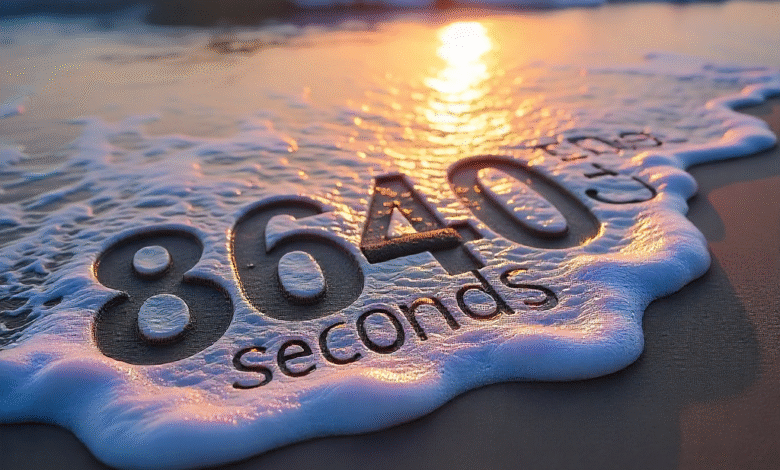How Many Seconds in a Day A Simple Breakdown

When we think about time, it’s easy to get caught up in hours, minutes, and maybe even days. But have you ever wondered just how many seconds make up a single day? The answer might surprise you, and it’s more interesting than you might think. Time, as they say, is precious, and understanding its units is an essential way to appreciate the pace of life. So, let’s dive into how many seconds there are in a day and explore why this simple calculation can hold deeper meaning.
Understanding Time: The Basics
Before we get into the math, it’s essential to understand the fundamental units that make up a day. Time, as we know it, is broken down into hours, minutes, and seconds, each serving a unique function to help us keep track of our lives.
A day, in its simplest form, consists of 24 hours. Each hour is divided into 60 minutes, and each minute is further divided into 60 seconds. These divisions are standard across the globe and serve as the basis for how we experience the passage of time.
Hours in a Day: The Foundation
We begin our day with hours. The world operates on a 24-hour clock, which gives us a full rotation of time from one midnight to the next. It’s important to remember that a day can be categorized into daytime and nighttime, but for this calculation, we’ll focus on the full span of 24 hours.
But how do these hours relate to seconds? This is where the magic of multiplication comes into play.
The Role of Minutes and Seconds
The clock ticks forward with 60 minutes in each hour. It is easy to overlook, but minutes are the crucial stepping stones leading to seconds. One minute is equivalent to 60 seconds. So, when we look at the overall breakdown, we see that a day is more than just a simple measure of hours.
The Formula: Calculating Seconds in a Day
Now that we’ve reviewed the units of time, let’s do the math. Here’s the step-by-step breakdown:
- 1 hour = 60 minutes
- 1 minute = 60 seconds
- 1 hour = 60 minutes × 60 seconds = 3600 seconds
- 24 hours = 24 × 3600 seconds = 86,400 seconds
Thus, there are 86,400 seconds in a single 24-hour day.
Breaking Down the Math with an Analogy
Think of time as a big jar, and the seconds are marbles that fill it up. Each day, we fill that jar with 86,400 marbles. If you imagine how quickly those marbles are added, you’ll begin to appreciate how swiftly time passes. Each marble represents a fleeting moment, reminding us to savor every second.
Why Does This Matter?
While this might seem like a simple calculation, understanding the number of seconds in a day can help us reflect on how we use our time. We are often focused on big events or milestones, but it’s the small seconds that accumulate and shape our days. By knowing that each day holds exactly 86,400 seconds, we can better appreciate how quickly those seconds pass and strive to make the most of every moment.
The Significance of Seconds in Our Lives
Why is it important to know how many seconds are in a day? It’s a simple fact, but it carries profound implications for how we structure our time. By thinking in terms of seconds, we start to realize just how precious time is.
- Every second counts: When we consider the finite nature of time, we become more mindful of how we use it. Rather than wasting hours, focusing on smaller intervals, like minutes or seconds, can help us make the most of our time.
- The importance of time management: If we manage our time wisely, we can maximize each of those 86,400 seconds, leading to greater productivity and fulfillment.
- Perspective on life: Understanding the number of seconds in a day brings clarity to the brevity of life. We can focus on the present, knowing that every second is an opportunity to create meaningful experiences.
The Science Behind Time Measurement
Time is measured using clocks, but how do we ensure they are accurate? In fact, the development of clocks and watches has a long history. Ancient civilizations used sundials, while modern-day atomic clocks are based on the vibrations of atoms. These advancements allow us to measure time precisely, down to the smallest fractions of a second.
How Does the Leap Year Affect Time?
One interesting factor to consider is the leap year. Every four years, we add an extra day (February 29th) to our calendars to keep in sync with the Earth’s orbit around the sun. This adds an additional 86,400 seconds every four years. While this doesn’t drastically change the number of seconds in each year, it does highlight the way our time-keeping system adjusts for astronomical phenomena.
Time Zones and Their Influence
Another interesting aspect of time is how it varies across different regions of the world. Time zones divide the globe into segments where the local time differs by a specific amount from UTC (Coordinated Universal Time). While this doesn’t affect the number of seconds in a day, it does mean that the passage of time is experienced differently depending on where you are. When it’s midnight in one part of the world, it could be the middle of the afternoon in another.
Time and Technology: Advancements Over the Years
As technology has advanced, the ability to track time has become even more precise. With devices like smartphones and smartwatches, we are constantly reminded of the time down to the second. In fact, these devices have made us even more aware of how quickly seconds can slip away, prompting us to track our time more efficiently.
How to Use Time More Wisely
Now that we know how many seconds are in a day, how can we make the most of them? Here are some tips:
- Set priorities: Focus on the things that truly matter, whether it’s spending time with family, working on personal goals, or taking care of your health.
- Eliminate distractions: Time is precious, so try to avoid wasting it on things that don’t add value to your life.
- Break down tasks: Use small intervals of time to tackle tasks. This can help you stay focused and prevent procrastination.
Conclusion
In conclusion, knowing that there are 86,400 seconds in a day is not just a simple math fact; it’s a reminder of how precious time is. By understanding the finite nature of each day, we can start to appreciate every second and use our time more wisely. Whether it’s improving productivity, fostering relationships, or simply taking a moment to relax, the key is to make every second count.
FAQs
1. Why do we measure time in seconds, minutes, and hours?
Time is divided into smaller units to make it easier to measure, understand, and manage. Seconds allow for precise tracking of short durations, while hours and minutes provide a more practical way of organizing our daily schedules.
2. How many seconds are in a year?
There are approximately 31,536,000 seconds in a non-leap year (365 days). In a leap year, it’s 31,622,400 seconds due to the extra day.
3. Can time zones affect the total number of seconds in a day?
No, time zones do not affect the total number of seconds in a day. A day is always 86,400 seconds, but the local time may vary depending on the location.
4. Why do we need leap years?
Leap years account for the fact that Earth’s orbit around the sun takes approximately 365.25 days. By adding an extra day every four years, we keep our calendars aligned with the Earth’s movement.
5. What’s the most efficient way to manage time?
Effective time management involves prioritizing tasks, setting clear goals, and eliminating distractions. Using tools like to-do lists or time-blocking techniques can help ensure you’re using your 86,400 seconds wisely.

